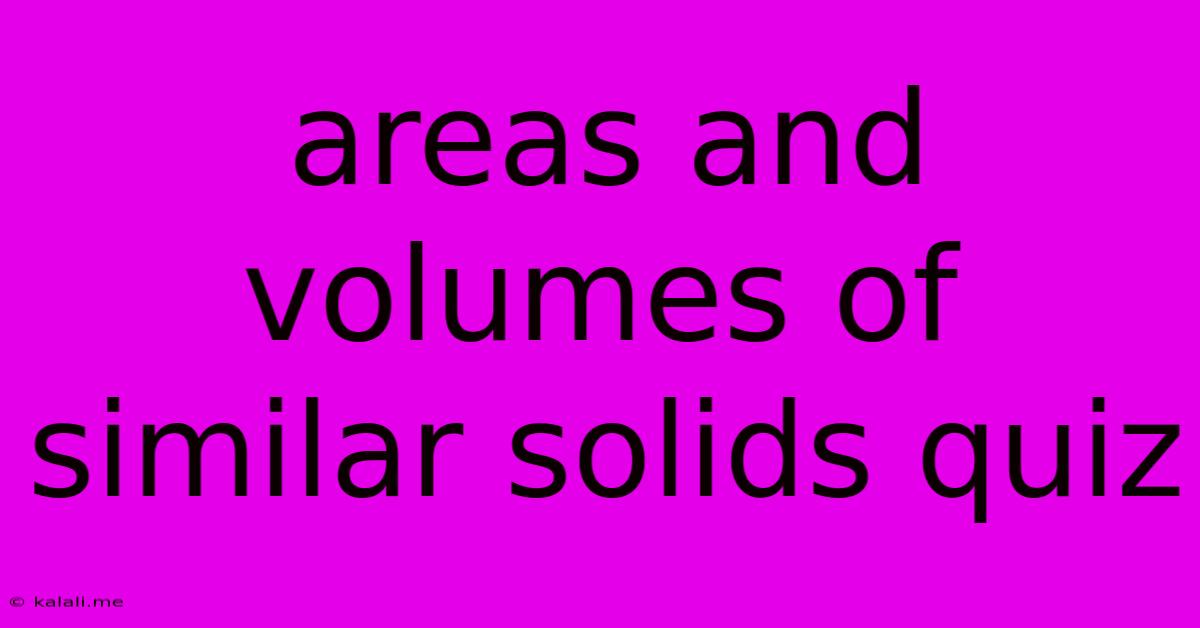Areas And Volumes Of Similar Solids Quiz
Kalali
May 09, 2025 · 3 min read

Table of Contents
Areas and Volumes of Similar Solids: A Comprehensive Quiz Review
This article provides a thorough review of the concepts surrounding areas and volumes of similar solids, perfect for preparing for a quiz or solidifying your understanding. We'll cover the key relationships, provide examples, and offer some practice problems to test your knowledge. Understanding this topic hinges on grasping the relationship between linear dimensions, surface area, and volume in similar figures.
What are Similar Solids?
Similar solids are three-dimensional figures that have the same shape but different sizes. Think of them as scaled versions of each other. All corresponding angles are congruent, and all corresponding linear dimensions (lengths, widths, heights) are proportional. This proportionality is the key to understanding the relationships between their areas and volumes.
Key Relationships:
Let's say we have two similar solids, Solid A and Solid B, and the ratio of their corresponding linear dimensions is k. This means if a side of Solid A is twice as long as the corresponding side of Solid B, then k = 2. This ratio k dictates the relationships between their surface areas and volumes:
- Ratio of Corresponding Linear Dimensions: k
- Ratio of Surface Areas: k² (The surface area increases by the square of the linear scale factor.)
- Ratio of Volumes: k³ (The volume increases by the cube of the linear scale factor.)
Examples and Explanations:
Let's illustrate this with a concrete example. Imagine two cubes. Cube A has sides of length 4 cm, while Cube B has sides of length 2 cm.
-
Find the ratio of corresponding linear dimensions (k): The ratio of the side lengths is 4 cm / 2 cm = 2. Therefore, k = 2.
-
Find the ratio of their surface areas: The surface area of Cube A is 6 * (4 cm)² = 96 cm². The surface area of Cube B is 6 * (2 cm)² = 24 cm². The ratio of their surface areas is 96 cm² / 24 cm² = 4, which is equal to k² (2² = 4).
-
Find the ratio of their volumes: The volume of Cube A is (4 cm)³ = 64 cm³. The volume of Cube B is (2 cm)³ = 8 cm³. The ratio of their volumes is 64 cm³ / 8 cm³ = 8, which is equal to k³ (2³ = 8).
Practice Problems:
-
Two similar cones have heights of 6 cm and 12 cm respectively. If the surface area of the smaller cone is 30π cm², what is the surface area of the larger cone?
-
Two similar rectangular prisms have volumes of 125 cubic meters and 27 cubic meters. If the height of the smaller prism is 3 meters, what is the height of the larger prism?
Solutions:
-
The ratio of linear dimensions (k) is 12 cm / 6 cm = 2. The ratio of surface areas is k² = 2² = 4. Therefore, the surface area of the larger cone is 4 * 30π cm² = 120π cm².
-
The ratio of volumes is 125 m³ / 27 m³ = 125/27. The cube root of this ratio gives us k = 5/3. Therefore, the height of the larger prism is (5/3) * 3 meters = 5 meters.
Conclusion:
Understanding the relationship between linear dimensions, surface area, and volume in similar solids is crucial for solving various geometry problems. Remember the key relationships: k, k², and k³. Practice using these relationships with different shapes and examples to build your confidence and master this important concept. By applying these principles, you'll be well-prepared for your quiz and beyond. Remember to always identify the scale factor (k) as the first step in solving these types of problems. Good luck!
Latest Posts
Latest Posts
-
What Fraction Is Equivalent To 1 2
Jul 13, 2025
-
What Is The Average Iq For A 9 Year Old
Jul 13, 2025
-
How Long Does It Take For Brandy Melville To Ship
Jul 13, 2025
-
How Many Times Does 3 Go Into 30
Jul 13, 2025
-
In What Episode Of Bleach Does Ichigo Ask Orihime Out
Jul 13, 2025
Related Post
Thank you for visiting our website which covers about Areas And Volumes Of Similar Solids Quiz . We hope the information provided has been useful to you. Feel free to contact us if you have any questions or need further assistance. See you next time and don't miss to bookmark.